The Pure Audio Power Amplifiers
Pure Audio design and build two models of power amplifier - the new Duo Stereo and the original Reference Mono. They share a similar outer chassis design and have common topologies but there are important differences that will determine which is the best for you.
Rated at 65 watts per channel, pure Class A operation, the Monos are Pure Audio's best work.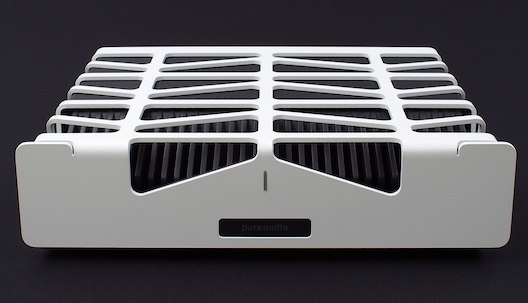
Reference Mono
When Gary first started working with Peter Thomson at Plinius, one of the ground breaking products was the SA50 Class A power amplifier. It still stands as one of their most poised designs - certainly my favorite. The liquidity of sound found in Class A designs is compelling and so it is no surprise that almost 20 years later, Gary has again gone to Class A for the power amplifiers. Read Gary’s article explaining Class A technology.
But we also have significant changes made from lessons learned with Plinius. More and more listeners (and designers for there are cases where it is possible to be both) are coming to appreciate that with solid state amplifiers there is a 'sweet spot' in terms of power. The specification war has resulted in bigger, more highly rated amplifiers - yet by their very nature they require banks of outputs, large and often noisy power supplies, massive heat-sinking and chassis. All of which is counterproductive when it comes to playing music - what point is the ability to destroy most speakers? Power is nothing if it obscures and overwhelms. Most large amplifiers are literally teetering on the precipice and hindsight has shown us that many of these designs - from all comers - are ultimately compromised in reliability and do not age gracefully with ever increasing noise issues.
While 65 watts may seem a modest rating in conventional terms, the reality is that the Monos are seriously capable amplifiers with more useable power and control than many more costly and higher rated designs. Sound quality is always our first consideration but there is no doubt that the Monos have more than enough power for the vast majority of systems. We've listened to these amplifiers in many settings since there introduction and have yet to hear better. As source quality has improved, the abilities of the Monos have been shown off to a higher degree - they are remarkably transparent, silent in operation yet capable of breathtaking dynamics and speed. The bass is a model of control and solidity.
Take a close look at the heat sink fins on the power amplifier - you'll see that they are actually the same sections that have been cut out of the cover. Minimising wastage is a key part of any modern design and Pure Audio take this seriously. Likewise when not in use the power amplifier automatically switches down to standby, consuming less power and extending its own life. The relatively small size and modest power rating means the amplifier can quickly cycle up optimum operation when an income signal is sensed.
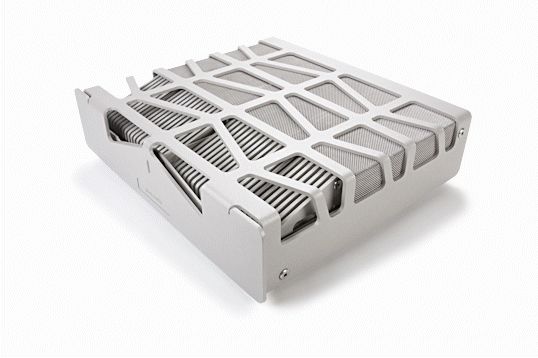
The Pure Audio amplifiers aren't the biggest, hottest or noisiest amps that have ever been made in NZ - and they are by no means the most costly for that matter. But what they are is the best sounding. Again, because both Gary and Ross were involved with Plinius until recently, the very best Plinius models were actually the starting point in terms of sound quality and they have gone from there. They are also more than aware of what other designers all around the world are doing, so there has been a real effort to produce something special that will work in a broad range of systems.
"Look through various Internet show reports—there seem to be an ever-growing number of audio events worldwide—and you see new companies daringly offering potentially great performing audio gear styled audaciously bold. In a crowded market these companies look for a point of difference, a black-box variance, a new aesthetic sensibility. Pure Audio’s three components so far comfortably fit this new vanguard of stylistically intrepid spirit. But it’s not just about style here.
The Control preamp and Reference monos are also beautifully assembled, contain quality components and have been expertly built by a team with an established rep in high-end audio. Given reasonably efficient speakers and mid-sized rooms this combo will provide a slightly sweet but not too syrupy sound with a generous low end and excellent tonal and textural articulation. Reincarnation may have produced a different perhaps more unencumbered version of what went before. Plinius still operates as a successful company of course and remains a powerful entity all of its own. But the new Pure Audio venture will perhaps allow its designers a freer hand to expand their ideologies, to express their views with conviction and to launch themselves assertively into the unpredictable waters of high-end audio once more. As our friends across the pond would say, choice ‘bro!" Read the full review here.
Pure Audio Reference Mono Power amplifiers NZ$7000 each
Specifications:
You can download a high resolution pdf copy of the product brochure here.
Pure Audio Duo Stereo Power amplifier
Following the success of the Reference Mono Class A Power Amplifier it made sense to offer another power amplifier targeting slightly different needs.
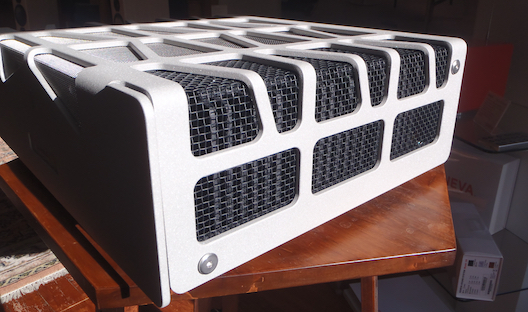
The Duo is, as the name suggests, a stereo power amplifier. Although outwardly similar, it is taller and heavier than a single Mono. Yet The Duo is still a true dual mono design with entirely separate power supplies for left and right channels. Being housed in one chassis it is less demanding of installation space and as you would expect, makes for a more affordable solution.
Where the Duo fundamentally differs from the Reference Monos is the ability to switch between two modes. The first mode is very much analogous to the operation of the Reference Mono - 25 watts into 8 Ohms in Class A, but with the equivalent of 100 Watts headroom. While this doesn't sound much, it is directly comparable to the best tube designs which are similar in terms of rated output, but achieve a far more relaxed and enjoyable tonality and room filling ability than almost any solid state designs. The common ground being that tube amps are by their very nature Class A designs. And if you know about single ended triode designs this is taken even further.
For almost all listeners this will be the ideal mode - in our estimation this is where you'll find the best sound quality and be able to listen without fatigue for as many hours as you choose - the liquidity and ease is equal to that of the Monos.
Sometimes you might what more driving ability - this may because of the genre of music, a more difficult speaker (although we are going to ask the question - why?), or simply that you want to party. This is something we can all relate to. For this, the Duo can switch to a high bias mode which suddenly brings us up to 80 Watts. More in fact than the Monos and while it is counterintuitive, it appears the Duo will outpace the larger amplifiers in terms of volume.
With Class A operation being somewhat inefficient Pure Audio conscious of the need to avoid excess energy wastage when the music stops and so designed the amplifier to fall back automatically to a low power standby mode when not in use.
The amplifier’s Class A operation is automated through both signal sensing and 12V trigger connections. When partnered with the Control Preamplifier via the 12V trigger circuit, Class A is activated when the preamplifier is brought out of standby.
The obvious question is why doesn't the Pure Audio Duo always run in this mode? There are several reasons. The first being power consumption. The high bias modes results in significantly higher power input and outward heat dissipation. While the heat-sinking and silent running fans mean the amplifier itself isn't under stress, this is wasteful for day to day operation. The actual headroom the amplifier has is not increased as the power supply itself is unchanged. You could think of it as electronic turbo charging.
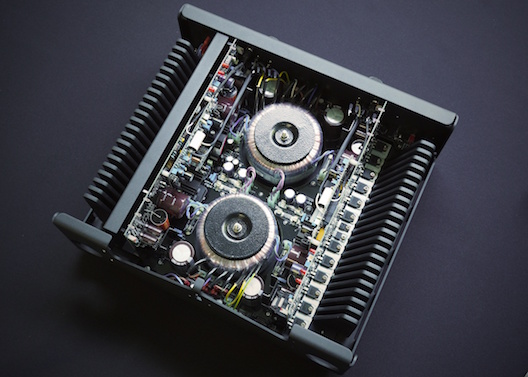
If you look inside the Duo (which you can through the mesh lining the ouster chassis) you'll see that the heat-sinking is distributed down each side of the amplifier, rather than in the front of the Mono.
In many ways the Pure Audio Duo is closer to the original Plinius designs than the Reference Monos. Given both Gary and Ross were the design team behind their best products and there have had a good 10 years to come up with better again, any existing Plinius owner will be able to look ate the Duo as their next power amplifier - you'll gain far better fidelity, a complete absence of the noise that plagued just about every early model and a much smarter sign in terms of power management.
If fact you'd be able to say the same for any Perreaux owner - Gary did some brilliant work before Plinius under his own 'Craft' brand which used MOSfets and so he's got plenty of experience in both camps - Pure Audio takes the best of all designs and delivers a far more modern and sophisticated amplifier. The Duo has more than enough real power to take on any of the brutal old amps but gives you something far more listenable and engaging.
Because if my long personal history with all the NZ made designs, I've come to see both their strengths and weaknesses. The advent of the NuPrime products has really shaken things up - they are smaller yet just as powerful, at once more detailed and smoother. And really significantly quiet in operation - these are qualities that the Pure Audio has to match and in fact better given its higher pricing.
So it is timely to do a direct comparison between the NuPrime ST-10 and the Pure Audio Duo.
Both power amps are stereo designs with similar driving capability - the NuPrime is rated at 150 watts and although the Pure Audio Duo clocks in at around 90 watts Class A in the high bias mode, in reality this is up with any 200 watt AB design
Physically they could not be more different - the Pure Audio is many times larger and heavier, with a level of build quality that the NuPrime doesn't come close to. Even the casual observer can see that the component selection and engineering of the Pure Audio is in another league
Yet the NuPrime is all about performance over cost - they use a unique design of amplifier which confounds the norm of Class A or B. Or even D. The low heat output from the NuPrime allows much smaller size and components are tightly packed which you can argue shortens the signal path length to good effect.
The NuPrime ST-10 is a class leader in terms of it's lack of background noise and high resolution. It is also remarkably smooth and rich - nothing like earlier high efficiency designs from the likes of Linn and Rotel. And in terms of value for money, there is simply nothing to touch it. In terms of ease of use, the ST-10 is brilliant - pick it up with one hand, plug it in and it goes. It's sensitive, has bullet proof protection, runs cool and leaves plenty of budget for other improvements within your system
So our question really is - can the Pure Audio Duo justify being roughly 3 times the cost of the ST-10?
In terms of material value for money that's a yes - you've got at least 3 ST-10s in there if you look at the quality of components and overall design. But a good portion of this is due to the choice of running Class A with the power supply and heat dissipation requirements.
The Pure Audio Duo needs physical room, both to fit and to breathe given the Class A design. It's a distinctive amplifier that won't be mistaken for anything else whereas the NuPrime can almost be overlooked.
The end sound quality has to swing it.
Our own listening shows the Pure Audio Duo to be quite distinct from the ST-10. NuPrime haul out the 'tube-like' description which is perilously close to a cliche and both amplifiers are warm and smooth when compared to conventional solid state. But the Pure Audio takes this a lot further. In both cases, bass control and a vanishingly low noise floor are clearly superior to most tube designs.
The sound of the Duo is very much a logical progression from both Plinius and Perreaux - the Plinius Class A approach and Perreaux's attachment to MOSfets were effectively sides of the same coin. Both were 'big' designs with sound and driving capability that was always going to be described as muscular. But this could also seem brutal. The Pure Audio Duo lacks nothing in control but deals in seduction, not coercion. The low power mode is directly comparable to the very best tube amplifiers in terms of the air and ease. This is Class A as it is supposed to be.
In the high bias mode the Pure Audio does have the edge in terms of the perceived power and driving ability - there isn't much in it but it does seem to have bit more control with larger speakers. I've never personally managed to make the NuPrime ST-10 activate it's protection circuitry but have had clients do this. In part, I think due to more difficult speaker loadings. It's here that the Pure Audio shows the value of two rather substantial transformers.
The main impression I have is that in order to really hear the Pure Audio's advantages, a system has to be well set up. The extra transparency and drive means that you'll hear more of what is happening upstream - the better sorted the system, the more obvious this becomes. The more demanding the speakers, the more obvious the differences are. But you'll also find attention to detail in terms of speaker placement, every cable and connection is mandatory - if you just through the Pure Audio Duo into any system, the first impression may be - 'is that all?' What it's telling you is that a system is the sum of its parts. The Duo won't cure upstream problems but if you feed it the right material, it will show you just what an exceptional power amplifier can do.
The NuPrime is highly likely to be someones first serious power amplifier, whereas the Pure Audio Duo is more likely to be a replacement within an existing component system - big old power amplifiers seldom age gracefully, becoming noisy and opaque sounding - what may have appealed 15 or 20 years ago just sound brutal and flat by comparison with what we can do today.
For many people practical requirements have changed - modern speakers tend to be far easier to drive and their innate transparency warrants and amplifier with matching characteristics. Lifestyle changes also mean ear shattering volume levels are simply not a requirement - so finally we can choose quality over quantity.
Of course music can be both exciting or relaxing. Likewise the Pure Audio can be switched between modes to suit. So the choice is yours.
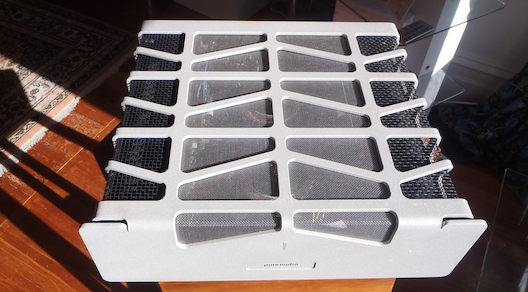
Pure Audio Duo stereo power amplifier NZ$9500
Specifications
Which Pure Audio model is right for you?
The presentation of differing power ratings with the two Pure Audio power amplifier modest does create a little ambiguity as to which is 'best'.
Let's first be clear about the power rating - when compared in exactly the same mode of operation - the default Class A, the Reference Monos are far more powerful than the Duo - 65 watts for the Monos, 25 for the Duo. So in this scenario, the two chassis solution offers greater depth, dynamics and a more open window to your music.
While the Duo is effectively two separate power amplifier in one box, the actual physical isolation of all parts including every element of the power supplies in the Monos takes this approach to the logical conclusion and this provides that extra spaciousness in the sound staging and ease that justify the no compromise approach.
The Duo does however benefit from all the lessons learnt in the production of the Monos and every designer can always think of some improvements that they can make - so this does allow for a much closer approach - and in fact of the face of it - an improvement over the original. The ability for the Duo to run in a more highly biased mode that produces a greater ability to drive to higher sound levels will be useful for some specific genres of music - in short it's got a real fun factor that you can literally turn on at will.
So if you make a comparison between the original Reference Mono and the new Duo, then yes - there will actually be some areas in which it is better despite being lower in cost. Conversely, there are things that the no-compromise design of the monos still does better - in a word the bigger amplifiers still have more air. The Monos have also had a series of subtle improvements made over time - this is what you'd expect with a hand-built product. And you can take it as likely that there will continue to be improvements. So when you are ready to make your choice, do so with an open mind.
The Duo is not a replacement for the Reference Monos. If you want the best performance and can afford it - go straight to the two box option. And in both cases, if you want to enjoy the full potential of either model, the matching Pure Audio Control preamp is an effective minimum - there is simply no other preamplifier at a lesser cost we know of that sounds better - but this isn't to say that some more costly models might well be better again.
Another factor is also to consider if the price difference between the two models may be better employed within your system. There have been startling improvements in digital and analogue front ends lately, and all connecting cables. The transparency of all Pure Audio products makes these improvements far more obvious than any lesser system. Conversely, the benefit of any of these attached components will be magnified by the better ultimate performance of the Reference Monos. The luxury of choice is a wonderful thing to have.
If connected directly to one of the newer generations of DACs and streamers, or products such as the Cambridge CXU, the Pure Audio power amplifiers are still sufficiently sensitive enough to sound very good indeed and show these sources to their best advantage - but again, the insertion of the Pure audio Control preamplifier will inevitably show you just what is in fact possible.
With speaker matching, I'd suggest that the Pure Audio products will enable you to hear the true sound of any speaker - they are not there to correct deficiencies. Quality will always win out over quantity and from my own perspective, the Pure Audios are the perfect match for something like the Sonus faber Olympicas - few combinations will match the air and ease of listening, the detailed and expansive soundstage and overall poise and tonal balance. The Pures will still do very cool things with serious floor standers of many breeds - the bass isn't brutal like some of the old NZ made warhorses - but it is far more natural and matched with greatly superior transparency over the rest of the frequency range.
The end cost of the Pure Audio components is a simple reflection of the quality of components used, the materials, care in manufacture and, to a small extent, development. In New Zealand there is a price advantage because there are lower distribution and freight costs and no external taxes. The tax, distribution and import situation in every country is different so if you are reading this from overseas, you'll understand that outside of a simple currency conversion, the end price will take this into account and so your best contact is always the designated dealer within your own country.
This doesn't stop you phoning or emailing us. While we are more than happy to answer your questions no matter where you are, we will not quote for or ship to any territory with existing or pending distribution arrangements. Outside of that proviso, we are here to sell things and Pure Audio is no exception. The bottom line in any situation will always be - 'is this the best sounding product that does what I want at a level I can afford?' We’re here to help you answer that particular question.
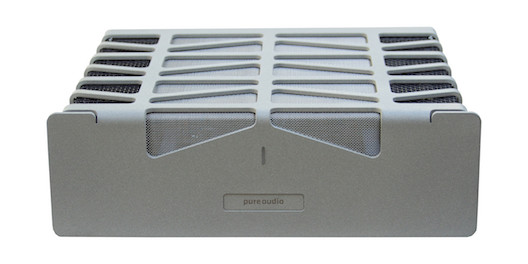
The Terrace Houses
217 Stuart Street
Dunedin 9016
New Zealand
NZ Toll Free
Phone
Cell Phone
Mail
0800 909 101
(+64) 03 4790 444
(+64) 021 963 321
info@totallywired.co.nz
Direct Contact
John Ransley and Carolyn Guytonbeck are the principals behind Totally Wired. It’s our own business and we take pride in building something worthwhile.
If you want to contact us directly per mail:
